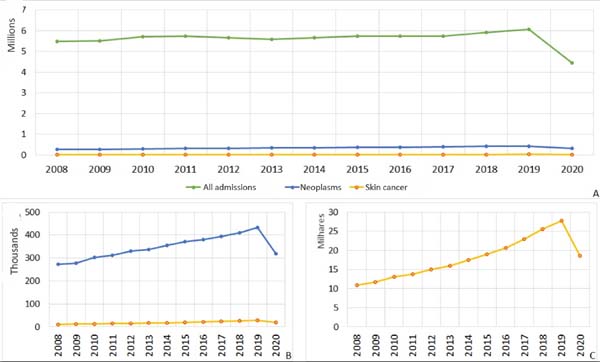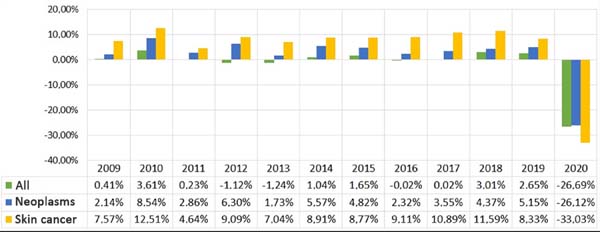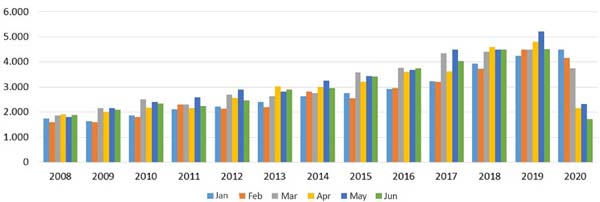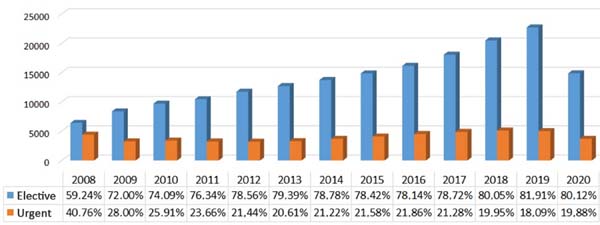INTRODUCTION
Skin neoplasms are a broad group of diseases, and malignant neoplasms receive greater
clinical emphasis due to their epidemiology and outcomes that are largely preventable
with early treatment. Skin cancers are the most common neoplasms globally, with an
estimated 2 to 3 million incidences in the non-melanoma type and 132,000 in melanoma
per year1. It is estimated that 1 in 3 diagnosed cancers occurs on the skin1.
Brazil mirrors global epidemiology and has an estimated annual incidence of 185,380
cases by 2020, with 4,120 deaths in 2018. In this scenario, skin cancer is the neoplasm
with the highest annual incidence2,3.
Neoplasms are the second leading cause of mortality in Brazil, but most skin cancers
have a good prognosis when diagnosed and treated early2. This is why maintaining and improving cancer approach programs is important.
The year 2020 is being marked by the fatalities and changes required to cope with
the COVID-19 virus. Therefore, this study’s importance is justified since it is necessary
that, given the impact on skin neoplasms’ treatment due to the influence of the COVID-19
pandemic, it is important to look for means that minimize its consequences.
OBJECTIVES
This work aims to measure the evolution of hospitalizations in general for neoplasms
and skin cancer in the period 2008-2020 and, from these data, quantify the impact
on the number of hospitalizations for skin cancer treatment.
METHODS
An epidemiological study was conducted in the DATASUS database (TABNET) covering Brazilian
municipalities from January 2008 to June 2020 regarding hospital admissions, elective
and urgent hospitalizations, for the treatment of chapters ICD-10, “malignant neoplasm
of the skin,” and “other malignant neoplasms of the skin”4.
This was followed by normative resolution number 510 of April 7, 2016, of the Ministry
of Health, which defines the researches that use public access information, made in
databases, whose information is aggregated, without the possibility of individual
identification and do not need to go through the research ethics committee (CEP)5.
The information system of the Ministry of Health has already published data for the
first six months of 2020 and, for this reason, was the period of choice determined
to create parallelism with previous years regarding the number of hospitalizations
in the chosen groups, the character of hospitalization (elective x urgency) and percentage
evolutions. These data were analyzed by the authors of this study in meetings at Santa
Casa de Montes Claros.
RESULTS
The hospitalizations performed in the Unified Health System, between January and June
2008 and 2020, were tabled and analyzed, resulting in figures 1A, 1B and 1C and Table 1. There was an increase in the total number of hospitalizations for all causes from
2008-2019: the total number of hospitalizations increased 10.60%, the number of hospitalizations
for neoplasms increased 58.65%, and the total number of hospitalizations for skin
cancer increased by 156.24%.
Figure 1 - Annual evolution of hospitalizations in Brazil from January to June 2008 to 2020.
A. Evidences the evolution of hospitalizations for all causes, neoplasms and skin
cancer in the SUS, in the first 6 months of each year, in millions; B and C. Are specific
of neoplasms skin cancers, respectively, in the first 6 months of each year, in thousands.
Figure 1 - Annual evolution of hospitalizations in Brazil from January to June 2008 to 2020.
A. Evidences the evolution of hospitalizations for all causes, neoplasms and skin
cancer in the SUS, in the first 6 months of each year, in millions; B and C. Are specific
of neoplasms skin cancers, respectively, in the first 6 months of each year, in thousands.
Table 1 - Number of general hospitalizations, neoplasms and skin cancer in Brazil in the first
six months (2008-2020).
| Year |
All admissions |
Neoplasms |
Skin cancer |
| 2008 |
5.495.649 |
272.415 |
10.820 |
| 2009 |
5.518.042 |
278.240 |
11.639 |
| 2010 |
5.717.400 |
302.015 |
13.095 |
| 2011 |
5.730.321 |
310.662 |
13.702 |
| 2012 |
5.666.376 |
330.234 |
14.947 |
| 2013 |
5.596.107 |
335.941 |
16.000 |
| 2014 |
5.654.255 |
354.641 |
17.426 |
| 2015 |
5.747.574 |
371.718 |
18.954 |
| 2016 |
5.746.614 |
380.344 |
20.680 |
| 2017 |
5.747.733 |
393.835 |
22.933 |
| 2018 |
5.921.025 |
411.028 |
25.592 |
| 2019 |
6.077.975 |
432.190 |
27.725 |
| 2020 |
4.455.777 |
319.297 |
18.567 |
Table 1 - Number of general hospitalizations, neoplasms and skin cancer in Brazil in the first
six months (2008-2020).
The first six months of 2020 showed a numerical reduction in hospitalizations in the
three groups compared to the same months of 2019: general hospitalizations reduced
by 26.69%, hospitalizations for all neoplasms reduced by 26.12%, while malignant skin
neoplasms reduced by 33.03%.
The percentage changes over the previous year, in the first six months of each year,
2008-2020, are recorded in figure 2.
Figure 2 - Percentage change in hospitalizations in Brazil from January to June 2008 to 2020.
Figure 2 - Percentage change in hospitalizations in Brazil from January to June 2008 to 2020.
The number of hospitalizations for skin cancer studied in the first six months of
the period is shown in Figure 3 and Table 2.
Figure 3 - Number of hospitalizations for skin cancer treatment in the first six months of each
year, from 2008 to 2020, in Brazil.
Figure 3 - Number of hospitalizations for skin cancer treatment in the first six months of each
year, from 2008 to 2020, in Brazil.
Table 2 - Hospitalizations for skin cancer treatment in Brazil in the first six months (2008-2020).
Year
2008
|
January
1.750
|
February
1.591
|
March
1.867
|
April
1.917
|
May
1.800
|
June
1.895
|
| 2009 |
1.638 |
1.591 |
2.155 |
2.017 |
2.149 |
2.089 |
| 2010 |
1.877 |
1.798 |
2.510 |
2.177 |
2.395 |
2.338 |
| 2011 |
2.119 |
2.294 |
2.310 |
2.165 |
2.581 |
2.233 |
| 2012 |
2.222 |
2.128 |
2.690 |
2.561 |
2.889 |
2.457 |
| 2013 |
2.409 |
2.200 |
2.640 |
3.027 |
2.821 |
2.903 |
| 2014 |
2.627 |
2.821 |
2.760 |
3.003 |
3.257 |
2.958 |
| 2015 |
2.764 |
2.551 |
3.588 |
3.199 |
3.442 |
3.410 |
| 2016 |
2.918 |
2.970 |
3.774 |
3.593 |
3.683 |
3.742 |
| 2017 |
3.234 |
3.214 |
4.336 |
3.619 |
4.490 |
4.040 |
| 2018 |
3.923 |
3.714 |
4.412 |
4.585 |
4.478 |
4.480 |
| 2019 |
4.235 |
4.492 |
4.491 |
4.800 |
5.205 |
4.502 |
| 2020 |
4.482 |
4.150 |
3.738 |
2.156 |
2.328 |
1.713 |
Table 2 - Hospitalizations for skin cancer treatment in Brazil in the first six months (2008-2020).
Figure 4 shows the evolution of elective and urgent hospitalizations for skin cancer treatment
from January to June 2008 to 2020.
Figure 4 - Numerical evolution of elective and urgent hospitalizations for skin cancer treatment
from January to June 2008 to 2020.
Figure 4 - Numerical evolution of elective and urgent hospitalizations for skin cancer treatment
from January to June 2008 to 2020.
DISCUSSION
The direct and indirect impact of COVID-19 infection is not yet fully known. The possible
theorized indirect results are reduced hospitalizations to other diseases due to the
scarcity of SUS resources or its contingency. Another French study, still in progress,
confirms in its preliminary reports a similar trend, with a drastic reduction in terms
of screening (-86%), diagnosis (-39%) treatment (-30%) when compared to the same period
of 20196.
The analysis of figures 1 and 2 and table 1 revealed that there was an increase in hospitalizations in the three groups from
2008 to 2019: general hospitalizations increased by 582,326 (10.60%), hospitalizations
for cancer in general increased by 159,775 (58.65%), and hospitalizations for skin
cancer increased by 16,905 (156.24%).
The comparison of the first six months of 2019 and 2020 revealed a reduction in the
total and the proportional number of hospitalizations: general hospitalizations decreased
by 1,622,198 (26.69%), cancer in general in 112,893 (26.12%) and skin cancer in 9,158
(33.03%).
The drop in the number of hospitalizations shows how skin cancer treatment may have
been affected, similar to what occurred in England, where there was a statistically
significant reduction in skin cancer diagnoses of 68.61%7.
Monthly hospitalizations for skin cancer in 2020 gradually reduced. January 2020 still
increased compared to 2019, while February, March, April, May and June 2020 were equivalent
to the number of hospitalizations with the same months of 2019, 2016, 2010 and before
2008. The impact of this change is best understood in Figure 5.
Figure 5 - Monthly variation of hospitalizations for skin cancer in the first six months, from
2008 to 2020, in Brazil.
Figure 5 - Monthly variation of hospitalizations for skin cancer in the first six months, from
2008 to 2020, in Brazil.
In line with other international projections, this trend in reducing the number of
cases treated may lead to a late diagnosis, with a worse prognosis in this cancers8.
Figure 4 shows that the rates of elective and urgent surgeries maintained their general downward
trend from 2008 (40% of urgent surgeries) until 2020 (19.88%), with small variances,
which shows no change to urgency in elective cases.
Given the absence of adequate diagnosis and treatment, there can be a considerable
increase in severity cases, according to studies by Tejera-Vaquerizo et al. (2020)
9, which estimated increased size and depth of squamous cell carcinoma and melanomas
in Spain during the pandemic. It was noticed in this study when there is a delay of
3 months in the diagnosis the projection and reduction of the survival in 5 years
of 5.2% for squamous cell carcinoma (SCC) and up to 30.2% months for the melanoma.
CONCLUSION
This study shows that SUS resources’ contingency led to a reduction in the total number
of hospitalizations, returning to lower monthly levels than 12 years ago. This isolated
data is an important indication of the indirect impact of the COVID-19 pandemic, as
it represents real, measurable and up-to-date data on the change of approaches to
other pathologies in this particular period.
Due to the delay in the various stages of approach to skin cancers, efforts should
be made to minimize the pandemic’s impact. In this context, we can highlight the standardization
of conducts, according to guidelines developed by institutions, such as the National
Comprehensive Cancer Network10. Besides, it is necessary to facilitate the patient’s access to the health system,
and telemedicine, cited in several sources as a facilitator of the follow-up of these
cases, is necessary 7,11,12.
In the specific case of skin cancer requiring reconstruction in a hospital environment
(and not just outpatient), these are patients with complex lesions. A few months may
undoubtedly represent the difference between curative surgery or just oncological
(palliative) hygiene. Due to acute and chronic diseases, the mortality curves presented
in the coming years will attest to the meaning of this fall in hospitalizations.
COLLABORATIONS
|
IFV
|
Analysis and/or data interpretation, Data Curation, Formal Analysis, Investigation,
Project Administration, Writing - Original Draft Preparation, Writing - Review & Editing
|
|
TRWC
|
Analysis and/or data interpretation, Conception and design study, Conceptualization,
Data Curation, Final manuscript approval, Formal Analysis, Investigation, Methodology,
Project Administration, Resources, Supervision, Validation, Visualization, Writing
- Original Draft Preparation, Writing - Review & Editing
|
|
LRS
|
Analysis and/or data interpretation, Conceptualization, Final manuscript approval,
Formal Analysis, Writing - Review & Editing
|
|
LAT
|
Conceptualization, Data Curation, Final manuscript approval, Formal Analysis, Writing
- Original Draft Preparation, Writing - Review & Editing
|
|
OJDM
|
Analysis and/or data interpretation, Conceptualization, Final manuscript approval,
Writing - Original Draft Preparation, Writing - Review & Editing
|
|
DFS
|
Data Curation, Formal Analysis
|
|
DSR
|
Data Curation, Formal Analysis, Resources, Writing - Review & Editing
|
|
PCA
|
Data Curation, Formal Analysis, Methodology
|
REFERENCES
1. World Health Organization (WHO). INTERSUN: the Global UV project [Internet]. Geneva:
WHO; 2020; [acesso em 2020 Ago 20]. Disponível em: https://www.who.int/uv/resources/FAQ/skincancer/en/index1.html
2. Ministério da Saúde (BR). Instituto Nacional de Câncer José Alencar Gomes da Silva
(INCA). Câncer de pele não melanoma [Internet]. Rio de Janeiro (RJ): Ministério da
Saúde/INCA; 2020; [acesso em 2020 Ago 20]. Disponível em: https://www.inca.gov.br/tipos-de-cancer/cancer-de-pele-nao-melanoma
3. Ministério da Saúde (BR). Instituto Nacional de Câncer José Alencar Gomes da Silva
(INCA). Câncer de pele melanoma [Internet]. Rio de Janeiro (RJ): Ministério da Saúde/INCA;
2020; [acesso em 2020 Ago 20]. Disponível em: https://www.inca.gov.br/tipos-de-cancer/cancer-de-pele-melanoma
4. Ministério da Saúde (BR). Departamento de Informática do SUS - DATASUS. Informações
de saúde, epidemiológicas e morbidade: banco de dados [Internet]. Brasília (DF): Ministério
da Saúde; 2020; [acesso em 2020 Ago 20]. Disponível em: http://tabnet.datasus.gov.br/cgi/deftohtm.exe?sih/cnv/nibr.def
5. Ministério da Saúde (BR). Resolução nº 510, de 7 de abril de 2016. Conselho Nacional
de Saúde. O Plenário do Conselho Nacional de Saúde em sua Quinquagésima Nona Reunião
Extraordinária, realizada nos dias 06 e 07 de abril de 2016, no uso de suas competências
regimentais e atribuições conferidas pela Lei n o 8.080, de 19 de setembro de 1990,
pela Lei n o 8.142, de 28 de dezembro de 1990, pelo Decreto n o 5.839, de 11 de julho
de 2006. Brasília (DF): Ministério da Saúde; 2020; [acesso em 2020 Ago 20]. Disponível
em: https://bvsms.saude.gov.br/bvs/saudelegis/cns/2016/res0510_07_04_2016.html
6. Brugel M, Carlier M, Essner C, Debreuve-Theresette A, Beck MF, Merrouche Y, et al.
Dramatic changes in oncology care pathways during the COVID-19 pandemic: The French
ONCOCARE-COV study. Oncologist [Internet]. 2020 Out; [citado 2020 Nov 10]; 26(2):e388-e41.
Disponível em: https://theoncologist.onlinelibrary.wiley.com/doi/10.1002/onco.13578
7. Andrew TW, Alrawi M, Lovat P. Reduction in skin cancer diagnoses in the UK during
COVID-19 pandemic. Clin Exp Dermatol [Internet]. 2020 Ago; [citado 2020 Nov 11]; 46(1):145-6.
Disponível em: https://onlinelibrary.wiley.com/doi/full/10.1111/ced.14411
8. Earnshaw CH, Hunter HJA, McMullen E, Griffiths CEM, Warren RB. Reduction in skin cancer
diagnosis, and overall cancer referrals during the COVID-19 pandemic. Br J Dermatol
[Internet]. 2020 Out; [citado 2020 Nov 08]; 183(4):792-4. Disponível em: https://onlinelibrary.wiley.com/doi/10.1111/bjd.19267
9. Tejera-Vaquerizo A, Cañueto J, Toll A, Santos-Juanes J, Jaka A, Ferrandiz-Pulido C,
et al. Estimated effect of COVID-19 lockdown on skin tumor size and survival: an exponential
growth model. Actas Dermosifiliogr [Internet]. 2020 Out; [citado 2020 Nov 09]; 111(8):629-38.
Disponível em: https://pubmed.ncbi.nlm.nih.gov/32513393/
10. National Comprehensive Cancer Network (NCCN). Advisory statement for non- melanoma
skin cancer care during the COVID-19 pandemic [Internet]. Plymouth Metting, PA: NCCN;
2020 Mai; [acesso em 2020 Nov 07]. Disponível em: https://www.nccn.org/covid-19/pdf/NCCN-NMSC.pdf
11. West H. Telemedicine for oncology: delivering on an overdue promise in the COVID-19
era. Front Oncol [Internet]. 2020 Set; [citado 2020 Nov 09]; 10:578888. Disponível
em: https://www.frontiersin.org/articles/10.3389/fonc.2020.578888/full
12. Rodin D, Lovas M, Berlin A. The reality of virtual care: Implications for cancer care
beyond the pandemic. Healthcare [Internet]. 2020 Ago; [citado 2020 Nov 09]; 8(4):100480.
Disponível em: https://www.sciencedirect.com/science/article/pii/S2213076420300798
1. FAMINAS-BH, Faculty of Medicine, Belo Horizonte, MG, Brazil.
2 . Hospital Santa Casa de Caridade de Montes Claros, Plastic surgery, Montes Claros,
MG, Brazil.
3 . Socor Hospital, Plastic Surgery, Belo Horizonte, MG, Brazil.
4 . Faculdades Integradas do Norte de Minas - FUNORTE, Faculty of Medicine, Montes
Claros, MG, Brazil.
5 . Dilson Godinho Hospital, Department of Plastic Surgery, Montes Claros, MG, Brazil.
Corresponding author:
Isabella de Fátima Vilela, Avenida Raja Gabaglia , 1123, Luxemburgo, Belo Horizonte, MG, Brazil. Zip Code: 30380-403.
E-mail: isaffarma@gmail.com
Article received: September 15, 2020.
Article accepted: November 19, 2020.
Conflicts of interest: none




















